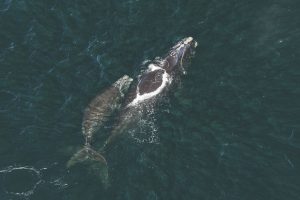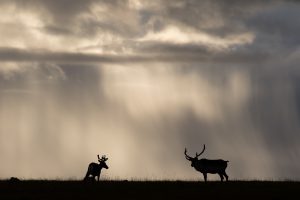
Wildlife
Punctuation’s mark: Can we save the critically endangered North Atlantic right whale?
After a series of mass deaths in recent years, what can we do?
- 4110 words
- 17 minutes
Wildlife
Plus: Alaskan wolves are getting a taste for sea otter, right whale-friendly lobster traps are hitting the market, AI is helping the fight against invasive phragmites, and First Nations discuss caribou protection

Around 52 million years ago, in the high latitudes of the Arctic, primate-like creatures roamed. The Arctic Circle was warmer, then, and hosted species such as ancient crocodiles, rodents and cow-sized butterflyfish living in a boreal ecosystem. But these “primatomorphans” still had to survive in the darkness for half the year.
“No primate relative has ever been found at such extreme latitudes,” says lead author Kristen Miller, a doctoral student at the University of Kansas’ Biodiversity Institute and Natural History Museum.
Miller’s research, recently published in PLOS ONE, focused on fossil specimens that were taken from Umingmak Nuna (Ellesmere Island) during the 1970s. Miller studied fossilized fragments of jaws and teeth to identify and name two species that are new to western science: Ignacius mckennai and Ignacius dawsonae.
These Ignacius were tenacious, squirrel-like critters that had evolved robust teeth and jaws in order to crunch through tougher-to-find foods during those dark winter months.
Their ancestors had clearly decided “to boldly go where no primate has gone before.”
This might be a glimpse into our own climate change-driven future, according to the research team, with other species boldly going towards the poles, evolving new traits for their new environments.

Wolves have a new prey of choice. After entirely eliminating the local deer population on Pleasant Island, Alaska, the resident wolves have quickly pivoted to feasting on sea otters.
Wolves first colonised Pleasant Island in 2013, and the deer population soon began to drop. According to scientists from Oregan State University and the Alaska Department of Fish and Game — who used GPS collars to track down wolves and analyze their scat — deer still accounted for 75 per cent of the wolves’ diet in 2015. But two years later, this had dropped to only seven per cent, while sea otters shot up to form 57 per cent of their diet. The pattern held through the end of the study period in 2020. The researchers believe this is the first case of sea otters becoming the primary food source for a land-based predator.
Sea otters are considered a top predator in near-shore ecosystems, more used to being hunter than hunted. Historically, both sea otters and wolves are likely to have occupied Pleasant Island. But with sea otter populations only recently rebounding in the region after being wiped out by fur traders in the 19th and 20th centuries, the two species have overlapped once more. This means more chance for predator-prey relationships to form.
Research has now expanded to Katmai National Park, southwest Alaska, over 1,000 kilometers away. Early research indicates wolves are also eating sea otters there. Good for the wolves, bad for the otters!

A new high-tech lobster trap may hold one key to the protection of critically-endangered North Atlantic right whales.
As a result of entanglement in fishing gear, vessel strikes and climate change, the North Atlantic right whale population has experienced a steady decline over the past decade, with population numbers dropping below 400. To curb this decline and better protect marine mammals, a Massachusetts-based marine manufacturing company, EdgeTech, has developed a high-tech lobster trap that can exist on the ocean floor without obstructing lines.
Using existing technology and acoustic release line systems, these new traps include a lead cage attached to gear which can be remotely called up by fishermen for retrieval when ready. When triggered, a line contained in the lead cage is deployed along with a buoy, floating to the surface and allowing the fishermen to hoist the cages in. The design therefore requires far less rope than traditional gear designs — and importantly for passing right whales, no fixed vertical lines. There are as many as 500 traps in Canadian and U.S. waters, some located 3,000 feet down and 100 miles offshore.
The goal is to help protect the critically-endangered North Atlantic right whale population while allowing the fishing industry to continue working in the waters they and the whales share.

It’s called the common reed. It is, indeed, common. But it shouldn’t be common in Quebec. Also known as Phragmites australis subsp. australis, the alien interloper is aggressive, spreading quickly through wetlands and wreaking havoc on local plant life.
A researcher from Montreal is hoping drones and AI will help conservationists stop new colonies from gaining a foothold. While the mature common reed colonies are pretty easy to spot — they’re more than five metres tall! — Antoine Caron-Guay of the Institut de recherche en biologie végétale has a plan to spot and stop the baby plants. He spent last summer flying drones over suspected spread areas, taking a series of high-resolution aerial photos to map large swaths of Îles-de-Boucherville provincial park. He then fed the photos into an AI program he had trained to look for common reed plants from above. The AI program can analyze new photos almost instantly and can spot the invasive reeds with 90 per cent accuracy.
Caron-Guay hopes his data can help conservation officers eradicate the reeds before they gain a chokehold. “I won’t change the world, but I hope that someday, like in a few years, I could come here and see that there’s a place where there’s no common reed,” he told CBC News. Top of his list? Someday soon seeing the return of the least bittern, an endangered bird species that has left the park since the common reed crowded out its natural habitat.

Organized by the Gwich’in Tribal council, the community of Fort McPherson, N.W.T, hosted its first ever Caribou Summit in January. And the takeaway from the three-day event was clear: the communities who rely on the Porcupine caribou herd, one of the largest herds in the world, must work to protect it.
As caribou herds around Canada suffer major declines, the Porcupine herd remains strong and healthy. In fact, they reached a historic high in 2018 with more than 200,000 animals counted.
There isn’t one single reason that’s been pinpointed to explain the herd’s success. However, it likely has to do with the proactive approach Indigenous communities have taken to managing the herds. In 1985, Gwich’in, Inuvialuit, and other First Nations governments signed the Porcupine Caribou Management Agreement, going on to create the Porcupine Caribou Management Board. Numbers, however, aren’t expected to stay high forever.
Topics discussed included ways to most respectfully hunt caribou — on foot rather than on snowmobiles and ATVs — as well as cutting down on meat wastage and creating a land guardian programme.
The leaders within the Gwich’in Nation are expected to convene again to make concrete actions in the coming weeks.
Are you passionate about Canadian geography?
You can support Canadian Geographic in 3 ways:

Wildlife
After a series of mass deaths in recent years, what can we do?

Wildlife
After more than a million years on Earth, the caribou is under threat of global extinction. The precipitous decline of the once mighty herds is a tragedy that is hard to watch — and even harder to reverse.

People & Culture
As the climate heats up, so do talks over land ownership in the Arctic. What does Canadian Arctic Sovereignty look like as the ice melts?

People & Culture
In this essay, noted geologist and geophysicist Fred Roots explores the significance of the symbolic point at the top of the world. He submitted it to Canadian Geographic just before his death in October 2016 at age 93.